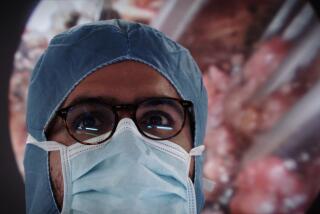Robotic surgery grows, but so do questions
- Share via
These days, some surgeons have four arms and are made of metal and plastic.
Use of a robotic assistant called the Da Vinci Surgical System has quadrupled in the last four years, and the machine now helps with incisions and sutures in 2,000 hospitals around the world. Da Vinci is a multi-purpose robot — the only one of its kind — that can scrub in on heart bypass and valve repair operations, hysterectomies, prostate removal surgeries and other procedures.
The Da Vinci robot is not actually performing operations; it only mirrors the movements of the surgeon’s hands on two joystick-like controllers.
Hospitals with the robot proudly proclaim its modern capabilities. Some patients insist on being treated by the mechanical surgeon.
But despite the Da Vinci’s popularity, its surgical talents may not surpass those of flesh-and-blood physicians.
“There’s never been a study showing clinical superiority,” says Dr. Marty Makary, a surgeon at the Johns Hopkins University School of Medicine in Baltimore. “For the patient, there’s clearly no difference.”
In a paper published in May by the Journal for Healthcare Quality, Makary made the case that the robot is more of a marketing tool to attract patients than a medical one to improve their care.
The maker of the machine, Intuitive Surgical Inc. of Sunnyvale, and the hospitals that use it often compare the robot to old-fashioned open surgery, in which the doctor makes a single large incision to get direct access to the internal organs. A Da Vinci operation is done laparoscopically, with tools inserted into small slits. Laparoscopic surgery, which can also be done by hand, is often associated with less pain and scarring and a shorter hospital stay than open operations. The benefits of robotic surgery are due more to the laparoscopic approach than to the robot itself, Makary says.
And he’s not the only one who thinks so. Since publishing his paper, he says, he has received kudos from colleagues who thanked him for speaking up about the issue.
Dr. Hyung Kim, a urologist who uses a Da Vinci system at Cedars-Sinai Medical Center in Los Angeles, is not sure that the robot makes a difference for patients. “The jury is completely out,” Kim says. “There is no consensus.”
But for surgeons, the robot is certainly a boon. Kim says he would never go back to performing prostate surgery by hand. Sitting comfortably at the ergonomic Da Vinci console, he can see the operating field better via a 3-D camera on one of the robot’s arms and maneuver his tools, held by other arms, more easily than if he were performing a traditional laparoscopic operation, he says. Surgery is less of a slog and a strain.
Unlike the rigid tools used in traditional laparoscopic surgery, the Da Vinci tools have “wrists” at their tips, allowing them to pivot and twist and making it easier for the surgeon to perform tasks such as suturing. The 3-D camera is also an improvement over the 2-D visuals used in standard laparoscopic procedures, says Christopher Simmonds, senior director of marketing services for Intuitive Surgical.
The surgeon “can use his instruments as if he had his hands inside the body,” Simmonds says. Plus, he adds, the robot filters out the hand tremors of tired surgeons.
The robot also has a major disadvantage, Makary says: The sensory feedback upon which surgeons rely is gone.
The Da Vinci can’t tell whether body parts are “firm, squishy, bony, soft, delicate or hard,” he says. Without that tactile information, it might be easier for a surgeon to accidentally cut the wrong body part.
Losing the sense of touch isn’t a big deal for physicians working with a system that is so “immersive,” Simmonds says. “After a while, they don’t even notice the fact that they don’t have the real [touch] feedback.”
Simmonds points to more than 4,000 published studies on the Da Vinci as evidence of its quality. Reports show that, compared with open surgery, there are fewer complications, less blood loss and faster recovery.
But many of those studies were “sloppy,” Makary says, and didn’t compare like to like. Ideally, researchers would test the Da Vinci’s effectiveness by randomly assigning patients to the robot or a traditional laparoscopic procedure. But that is difficult to do when patients have different needs and some request the robot by name.
Only a handful of studies included random assignment to robotic or manual laparoscopic surgery. Of those, two found that robotic surgery took longer than the hands-on alternative; in another study, the robot was faster. One study of 20 patients published in the journal Surgical Endoscopy in 2004 suggested that people who had an adrenal gland removed with the robot were more likely to have complications that required the surgeon to open them up all the way than those who underwent traditional laparoscopic surgery.
The Institute for Clinical and Economic Review, an independent healthcare evaluator at Massachusetts General Hospital in Boston, examined Da Vinci surgery as part of a 2009 report on prostate cancer treatment. There was no evidence of major benefit from the robot compared with open surgery, says Dan Ollendorf, the institute’s chief review officer.
What matters most, Ollendorf says, is the experience of the surgeon, not the chosen tools.
The cost of performing surgery is higher with the robot, albeit not for the person on the table. A Da Vinci system costs between $1.2 million and $2.2 million. Including the cost of single-use accessories, the robot adds approximately $1,600 to the cost of an operation, an increase of about 6%, according to a 2010 analysis in the New England Journal of Medicine.
Patients and insurance companies pay the same for a Da Vinci assist as for a by-hand procedure; the hospital absorbs the extra expense. In return for their investment, hospitals can advertise their “cutting-edge” capabilities, Makary says, attracting not only surgical patients but also others who will assume it’s the best place to get any kind of care.
Simmonds says the Da Vinci truly shines in complex operations that would otherwise require open surgery. For example, he says, if a person has a tumor on the kidney, it’s preferable to remove only part of the organ, but that’s difficult to do laparoscopically because it involves a lot of suturing — a task at which the robot excels.
Despite his doubts, Makary says he’s “definitely not anti-robot.” For instance, if magnification improves, a robot could make surgeries faster on small areas, such as the throat or heart valves.
“I do think there’s a role in the future for robotic surgery,” he says.






